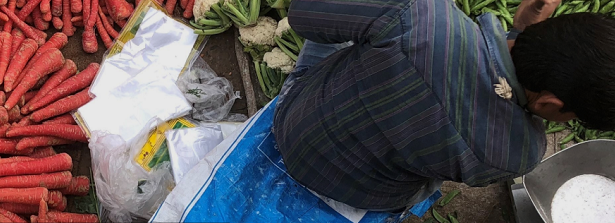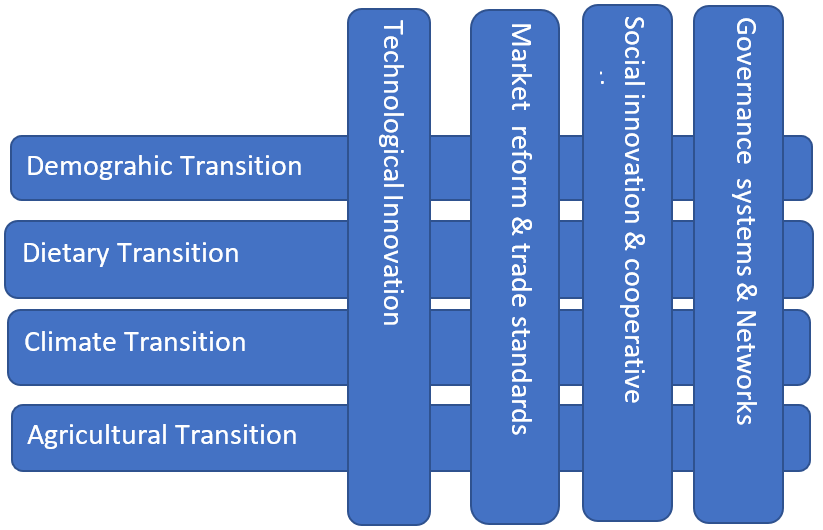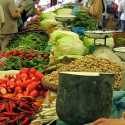How to support the food system transformation – a practical framework

An important insight in recent years is that our major economic systems do not deliver the right results and are not sustainable. The food system is one of those key systems. The demand for more nutritious food to feed a healthy and productive global population cannot be met if we don’t achieve fundamental changes. But where to start? How do we engage and leverage different stakeholders in the food system from farmers, companies and governments to consumers? In this blog Paul van de Logt and Ruerd Ruben1 present a practical framework for action based on their experience in policy and science to support food system transformations.
Policy makers and development partners engaged in strategies for eradicating poverty and malnutrition to support the Zero Hunger challenge of SDG2 are increasingly relying on a Food Systems Approach to identify suitable public policies and incentives and business innovations for achieving healthier diets. Translating food systems thinking into practical tools and criteria for development interventions requires a good understanding of the dynamics of societal transformation processes as well as adequate insight into the opportunities for steering these processes towards more inclusive and sustainable outcomes.
The food systems framework we outline aims to provide insights into the structure, behaviour and performance of the interlinkages between food production and consumer’s choices. It enables users to analyse how potential trade-offs between different food systems dimensions (such as access, availability, safety, affordability, and resilience) can be addressed and how synergies can be enhanced. Identifying suitable interventions in such a multi-layered and multiple stakeholder framework poses clear challenges to policy-makers and practitioners alike. It is therefore critically important to better understand the interfaces between structural change processes in society and the impact of different types of development interventions or business investments.
To achieve a systematic appraisal of potential strategies to support food system transitions, we outline an iterative framework that consists of three major stages:
- Understand the societal demands arising from different societal transitions in the areas of agriculture, demography, income and diets, and climate change;
- Identify the full range of intervention strategies, ranging from technologies and market development to social innovation and adaptive governance regimes;
- Evaluate the interventions and leverage points where there is an established evidence base demonstrating the likely impact for key stakeholders (see Figure 1).
The interactions between these three stages create progressive insights into the local opportunities and constraints associated with different interventions and the trade-offs and synergies between major food system objectives, based on the information and shared experiences gained from different stakeholders.
Understand societal transitions
The first step requires analysing different transitions in demography, diets, climate and agriculture that can provide or undermine the healthy diets needed within planetary limits. Valuable insights have been provided by the 2018 Eat Lancet report, combined with knowledge from cross-country analyses regarding agro-food systems transformation. Available evidence consistently indicates a steep increase in urban population shares, and rising incomes that lead to rapidly changing diets towards more vegetables and animal-based proteins. Agricultural production becomes more market-oriented and pathways to agricultural intensification may imply some farm consolidation and employment shifts towards off- and non-farm activities. Emerging challenges from climate change increase vulnerability and risk and are likely to ask for addition investment for adaptation and mitigation.
Figure 1 : Framework for analysing Agri-Food System Transformations

Identify intervention strategies
The second step yields insights into a number of potential interventions that may contribute to improved food systems performance. The range of possible actions is extensive, but we are particularly interested in those interventions that consistently influence the earlier identified agro-food system transitions. This implies that we need a thorough understanding of the effectiveness of specific technological innovations, market-based incentives or improved governance networks in accordance with the ongoing agri-food transitions. Therefore, we are particularly interested in possible interactions between these instruments that are able to achieve several key food systems outcomes simultaneously (for example, sustainable and healthier diets). Finally, we need to understand how separate or joint interventions can induce feedback loops between different levels in the food system or generate dynamic spill-over effects between public and private stakeholders that influence the overall performance of the food systems. This implies that there is growing need to use systems modelling and scenario planning, foresight approaches and decision-support tools that provide insights into opportunities for multi-stakeholder cooperation and public-private coordination.
Evaluate impact and leverage points
The third step calls for comprehensive insights into the likely impact of different types of interventions for generating the desired food system outcomes for each of the food system stakeholders. This is where systematic data gathering from robust, real-time and reliable impact studies is very useful. Moreover, the information collected by international agencies and networks (such as the OECD, World Bank, SPIA-CGIAR, J-PAL and ATAI) could be better coordinated and summarized in systematic reviews in order to improve external validity and broader relevance. The WEF Global Future Council on Food Systems Innovation could play a role in this convening process.
Taking a systems approach to food can be a valuable solution if we use the concept as a practical tool and not only as a policy concept. In this blog we have offered a practical framework to do so. We hope that the donor community supported by the major multilateral organisations will adopt a more harmonized approach to analyse where global, national and local food systems most need to be transformed and what types of interventions have the highest impact for delivering more inclusive, nutritious and sustainable results. The 2021 Food summit could be an opportunity to move this thinking further.
Further reading |
|
Footnotes
- 1. Paul van de Logt is head of the Nutrition and Food Security team at the Dutch Ministry of Foreign Affairs; Ruerd Ruben holds the chair of Impact Assessment for Food Systems at Wageningen University & Research.






